
ADVANCED MACROECONOMICS Lecture 3b Diamond Model 电子科大经管学院马捷
ADVANCED MACROECONOMICS Lecture 3b Diamond Model 电子科大经管学院 马捷 1
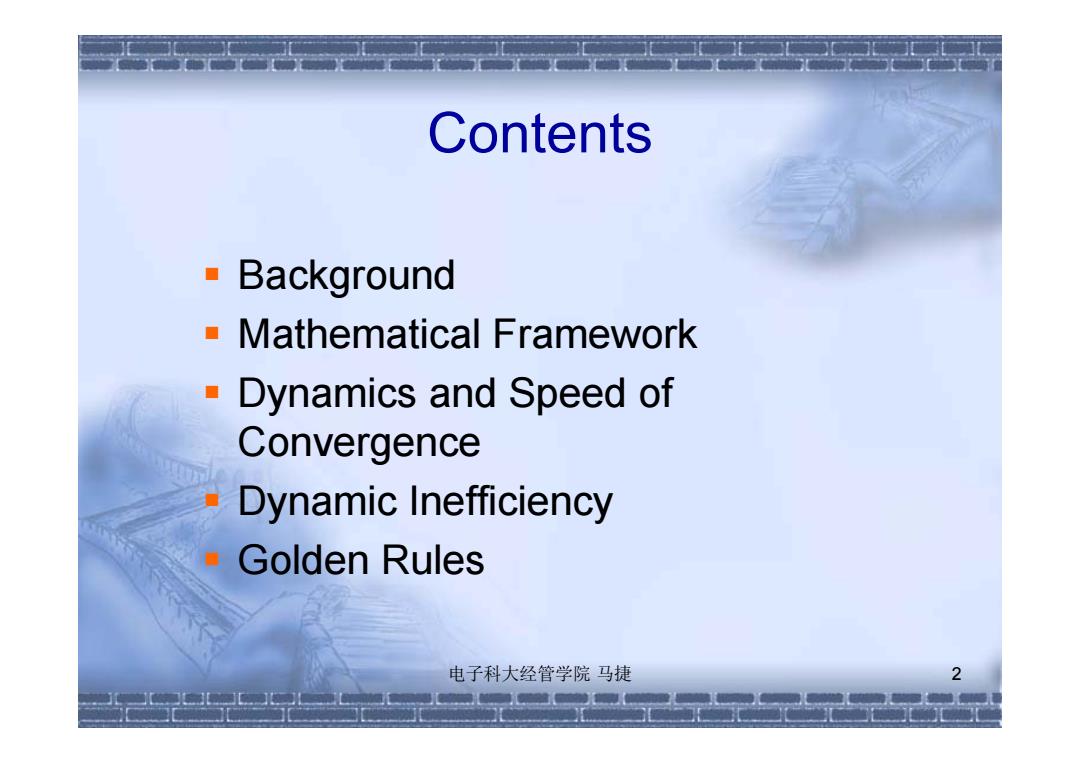
Contents ·Background Mathematical Framework ·Dynamics and Speed of Convergence Dynamic Inefficiency Golden Rules 电子科大经管学院马捷 2 元元元元
Contents Background Mathematical Framework Dynamics and Speed of Convergence Dynamic Inefficiency Golden Rules 电子科大经管学院 马捷 2
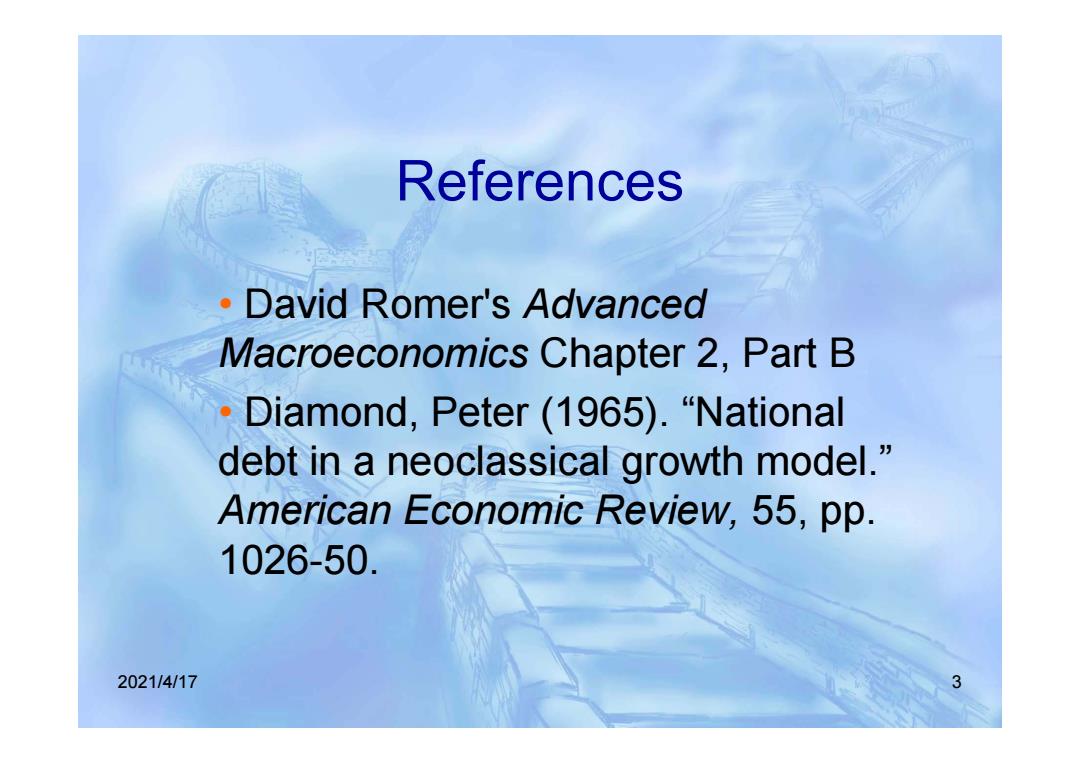
References David Romer's Advanced Macroeconomics Chapter 2,Part B ·Diamond,Peter(1965).“National debt in a neoclassical growth model." American Economic Review,55,pp. 1026-50. 2021/4/17 3
2021/4/17 3 References • David Romer's Advanced Macroeconomics Chapter 2, Part B • Diamond, Peter (1965). “National debt in a neoclassical growth model.” American Economic Review, 55, pp. 1026-50

Reflects of the debate on the Ricardian equivalence In the 1980s,US had run large budget deficits Traditional view:C~current income 'Budget deficits→C increases→Saving drop→ growth Ricardian Equiv:a shift from tax to bond finance has no influence on capital accumulation During recession periods,government often cut taxes.But if Ricardian equiv holds,these efforts are futile. It is important for us to know which view is closer to the fact. 2021/4/17
2021/4/17 4 In the 1980s, US had run large budget deficits • Traditional view: C~current income Budget deficits C increases Saving drop growth • Ricardian Equiv: a shift from tax to bond finance has no influence on capital accumulation During recession periods, government often cut taxes. But if Ricardian equiv holds, these efforts are futile. It is important for us to know which view is closer to the fact. Reflects of the debate on the Ricardian equivalence

Debate on the Ricardian equivalence Since the implications of the Ramsey model for public finance are so strong,it is worth pausing to consider which assumptions are essential. The debate has centered around Ricardian equivalence. 。Infinite horizon→Diamond's OG model Perfect capital markets>liquidity constraints are key assumptions underlying Ricardian equivalence 2021/4/17 5
2021/4/17 5 Debate on the Ricardian equivalence Since the implications of the Ramsey model for public finance are so strong, it is worth pausing to consider which assumptions are essential. The debate has centered around Ricardian equivalence. • Infinite horizon Diamond’s OG model • Perfect capital markets liquidity constraints are key assumptions underlying Ricardian equivalence
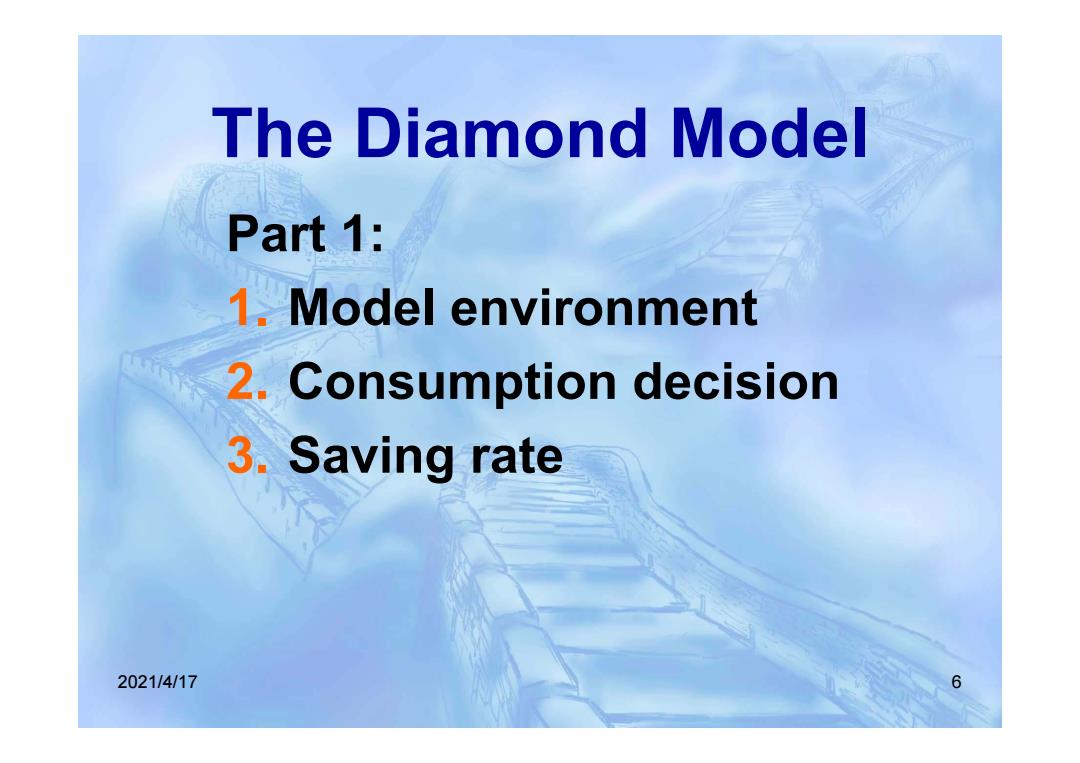
The Diamond Model Part 1: 1.Model environment 2.Consumption decision 3.Saving rate 2021/4/17 6
2021/4/17 6 The Diamond Model Part 1: 1. Model environment 2. Consumption decision 3. Saving rate
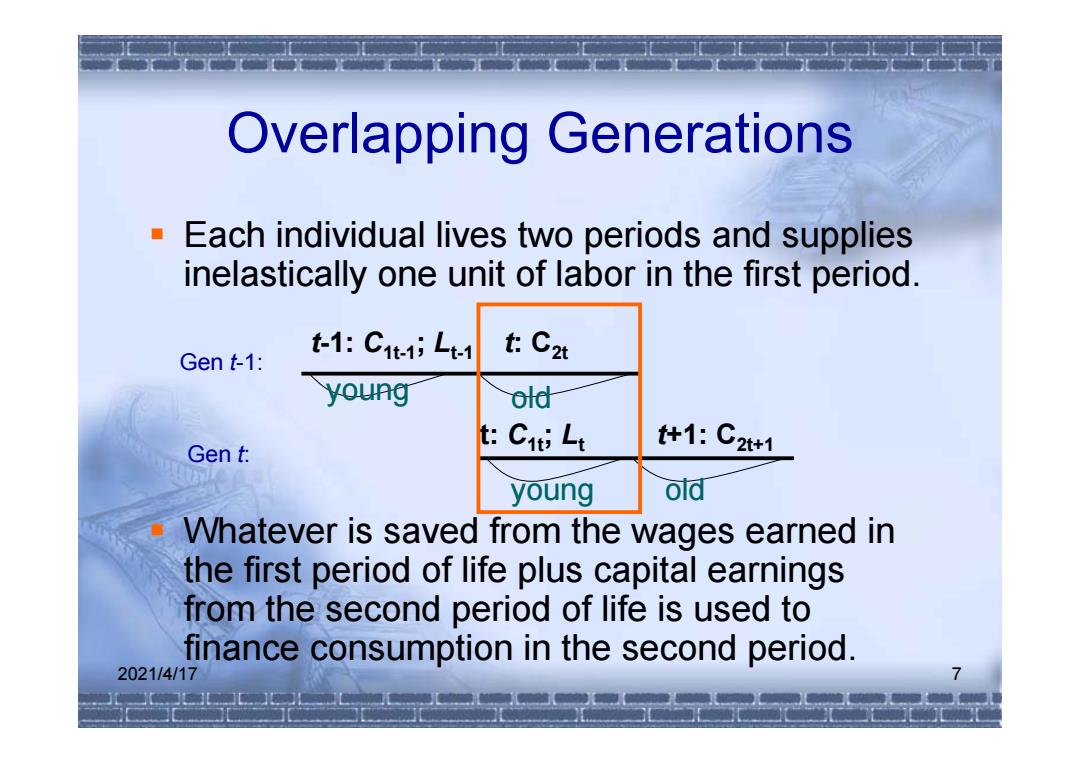
Overlapping Generations Each individual lives two periods and supplies inelastically one unit of labor in the first period. Gen t-1: t-1:C1t1;Lt1 t:C2t young old Gen t: t:Cuti Lt +1:C2t+1 young old Whatever is saved from the wages earned in the first period of life plus capital earnings from the second period of life is used to finance consumption in the second period. 2021/4/17
2021/4/17 7 Overlapping Generations Each individual lives two periods and supplies inelastically one unit of labor in the first period. Whatever is saved from the wages earned in the first period of life plus capital earnings from the second period of life is used to finance consumption in the second period. t-1: C1t-1; Lt-1 young old Gen t-1: t: C2t t: C1t; Lt young old Gen t: t+1: C2t+1
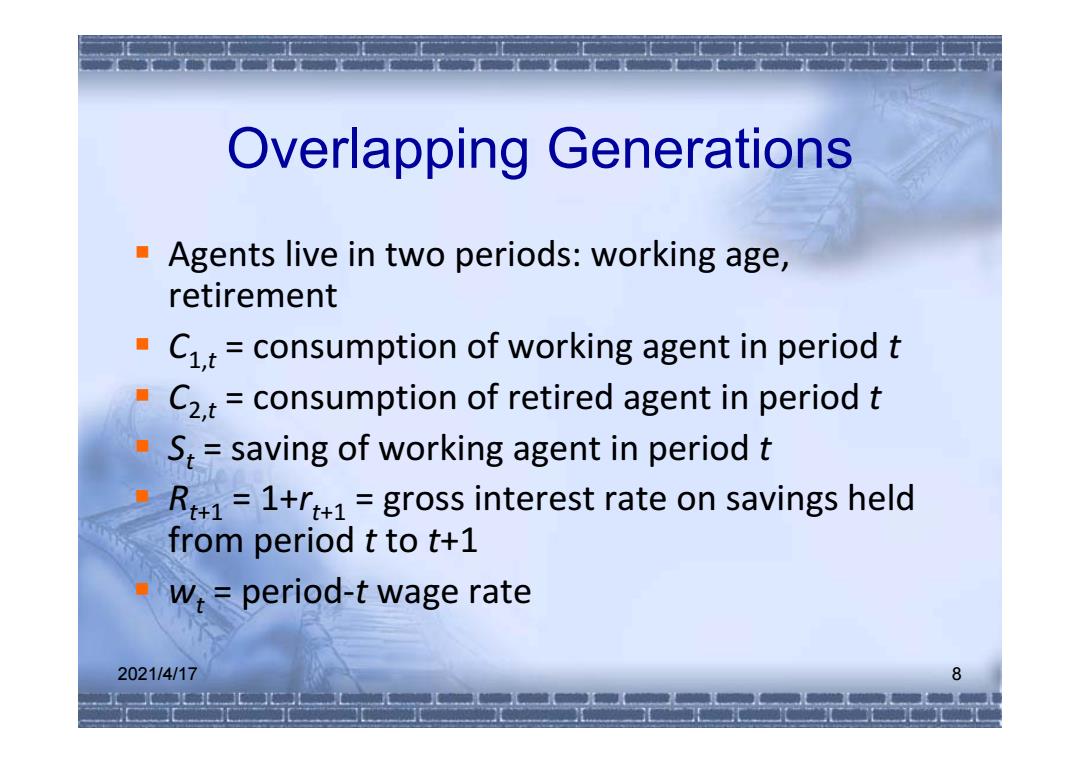
Overlapping Generations Agents live in two periods:working age, retirement C1,t=consumption of working agent in period t C2.t consumption of retired agent in period t S:=saving of working agent in period t R1=1+r+1=gross interest rate on savings held from period t to t+1 w,=period-t wage rate 2021/4/17 8
2021/4/17 8 Overlapping Generations Agents live in two periods: working age, retirement C1,t = consumption of working agent in period t C2,t = consumption of retired agent in period t St = saving of working agent in period t Rt+1 = 1+rt+1 = gross interest rate on savings held from period t to t+1 wt = period‐t wage rate

Preference: U,= 1 1-01+p1-0 CRRA coefficient:0>0,determines the willingness of a household to shift first-period consumption to the second period. the smaller is 0 the more willing is the household to shift consumption to gain utility, the higher is 0 the more risk-averse the household is which means she prefers to consume current income in the current period and would ask for a high return on savings before he shifts a small fraction of income. Time discount rate:p>-1 If p is greater(smaller)than zero the household places a greater (lower)weight on first period consumption than on second-period consumption 2021/4/17 9
2021/4/17 9 Preference: CRRA coefficient: θ>0, determines the willingness of a household to shift first-period consumption to the second period. • the smaller is θ the more willing is the household to shift consumption to gain utility, • the higher is θ the more risk-averse the household is which means she prefers to consume current income in the current period and would ask for a high return on savings before he shifts a small fraction of income. Time discount rate: > -1 • If is greater (smaller) than zero the household places a greater (lower) weight on first period consumption than on second-period consumption. 1 1 1 21 1 1 11 t t t C C U
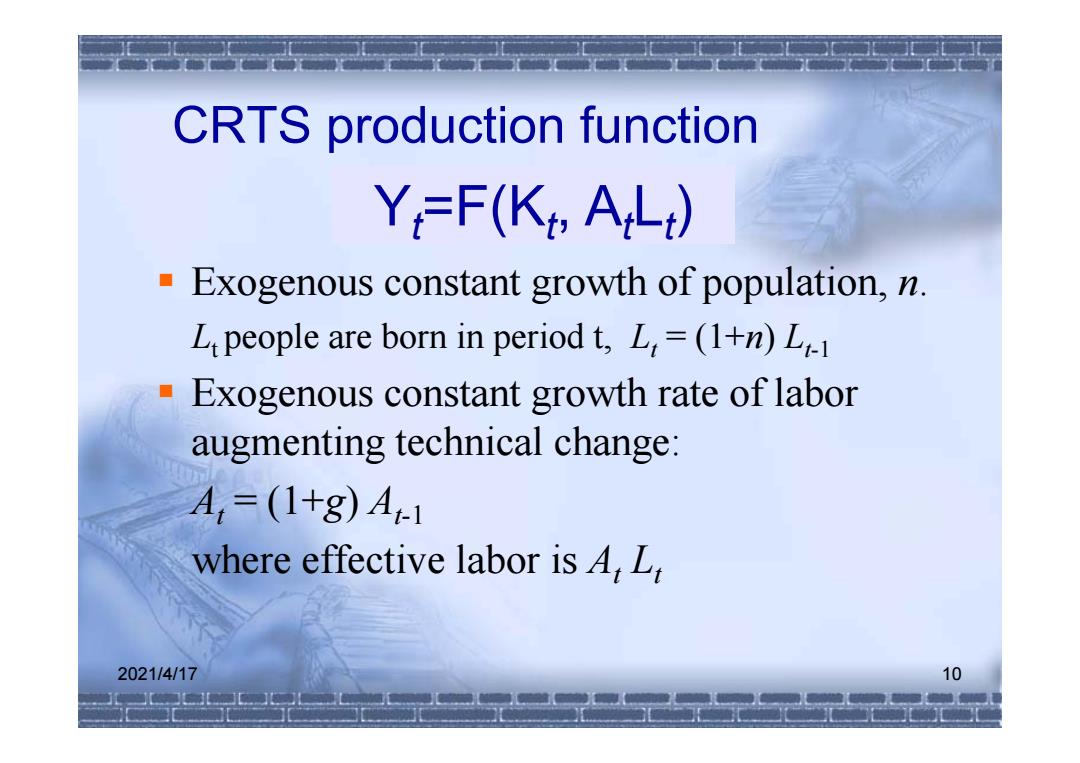
CRTS production function Y=F(K AL) Exogenous constant growth of population,n. L people are born in period t,L=(1+n)L Exogenous constant growth rate of labor augmenting technical change: A,=(1+8)A1 where effective labor is 4,L 2021/4/17 10
2021/4/17 10 CRTS production function Exogenous constant growth of population, n. Lt people are born in period t, Lt = (1+n) Lt-1 Exogenous constant growth rate of labor augmenting technical change: At = (1+g) At-1 where effective labor is At Lt Yt=F(Kt, AtLt)